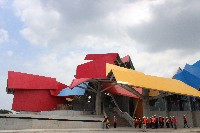The Frank Gehry Biodiversity Museum

Driving over the bridge of the Americas catch a glimpse of the Biodiversity Museum, an architectural icon in Panama. The colourful metal building, designed by world-renowned Architect Frank Gehry, will be the first of its kind in Latin America. The Arial view is somewhat chaotic. Up close, the building seems out of place, sitting besides an old Canal Zone building. Since Gerhy’s work usually reflects the country it stands in, I was curious how the bio museum reflected Panama. Every Saturday, tours of the construction site are open to the public. I decided to take a tour with some friends. We met a group of design students and Margo Lopez, the museum's communications director, to learn about the museum.
Margo explained Gehry’s sketches usually start at a very abstract level. Line drawings are then transformed into models. In order to stay detached from the models Gehry works in a wide range of sizes and materials.
Ground broke in 2004 on the causeway. After two years the construction continues. The museum’s doors will open in 2015.
Margo was fundamental in explaining the Gehry's design and vision. "Gehry envisioned people actually using the area,” said Margo. Skaters skating, people talking, walking and enjoying the space.The museum will offer a public plaza and garden, access to these areas will be free, encouraging human interaction.
Margo explained the building itself spoke to the history of Panama. The metal roofs resemble those used in canal construction. The primary colours mimic shipping containers passing through the canal. And varying levels of roofing are representational of the different layers of the forest canopy.
After hearing what Margo knew about the design and its purpose, things were starting to make sense. Gerhy’s design seemed a lot less like a crumpled piece of paper, as each line revealed its purpose.
The building provieded larger representation of Panama. As rainwater runs off the buildings walls, it gathers in a gravel pond surrounding the building. The galleries represent the rocks rising to create the Isthmus of Panama. The water basin mirrors the oceans that surround the country.
The building is being built to LEED standards, working towards LEED certification. Double doors are strategically placed to keep the cold air in and the warm air out. Furthermore, the building seeks to be self-sustainable. Rainwater gathers in basins around the building creating a supply to be reused in the building’s daily operations. The roof of the building is designed to keep almost 100% of the heat out.
Bruce Mau will be designing all eight galleries. Phase A (the first phases of the project) will be completed this August. Before Mao began his designs, he read a quote by Charles Darwin, it read: “what explains all this riot.” This was the conceptual jump off from which each gallery grew.
The scientific content, developed by the Smithsonian Institute and University of Panama, sheds light on Panama as an important geographical feature. Panama has created a large amount of biodiversity, as the land bridge joined lands and divided oceans. Together Gehry, Mao the Smithsonian and U of Panama, work to tell the story of how the Isthmus of Panama changed the planet.
The Bio Museum will serve as a great educational tool. Moreover it stands to create a sense of community, not seen in the area before. Casing a shadow on the old affairs club, where Panamanians were once not permitted to enter. Today the old building functions as the museum’s administrative office.
To book a tour contact the Museum by email at consultas@biomuseopanama.com or by phone at (507) 314-0097














